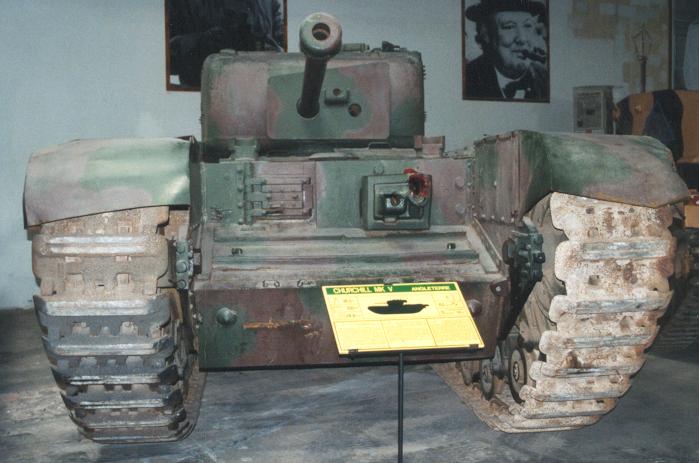

(Saumur Tank Museum)
[history] [B1 tank] [crewing the B1bis] [APX4-turret] [B1bis weaknesses] [production] [other prototypes] [beute-B1bis] [specifications] [sources]
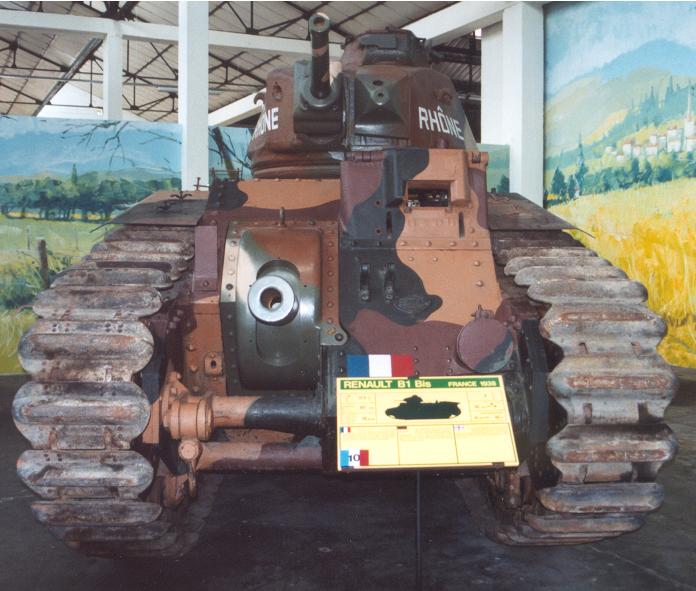
The B1bis battle tank of Saumur Tank Museum
The B1bis Battle Tank



In 1940, the B1bis was the result of the french battle tank program
of the thirties. Two factors played a crucial role in the development of
the french battle tank:
- First, the apparition
of new high velocity anti-tank guns which could pierce 40 mm of armor at
400 m (the average combat distance)
- Second, the disarmament
conference of Geneva which could limit the weight of tanks to 16, 20 or
25 tons.
At that time, the battle tank prototype had already a weight of nearly
25 tons with an armor of 25 mm. The armament consisted of a 75 mm gun in
the hull (without any lateral movement possible, ) and a turret with two
machine guns. The tank was equipped with a radio. Its motor had 180 Hp
and allowed the tank to reach a maximum speed of 24 km/h. Since the tank
needed 2.2 liters of fuel per km, a trailer (with 400 liters) was attached
to the tank for its strategic movement.
Since the armor of the prototype was not sufficient to resist to the new anti-tank guns, it was decided to shield the tank with an armor of 40 mm. The armament of the tank was judged to be not suitable for tank combat. Therefore, it was decided to replace the machine guns with a new 47 mm gun. The turret of the D1 tank could not accomodate the new 47 mm gun. A new turret had to be design: it would be the APX1 turret which would also be used on D2 and Somua S35. Seven new prototypes were ordered by the Army to form an experimental unit in 1932. But these tanks were not built until the breaking of the Geneva disarmement conference in 1934. Finally in 1935, a total of 35 B1 tanks had been ordered by the Army to form a tank battalion. The order would be completed by July 1937 (the first B1 tank had been delivered in December 1935). But the battalion would only be operational in January 1938 after the tanks received their APX1 turrets.
TheB1 tank had the following caracteristics:
- Combat Weight (tons): 28.0
- Dimensions
Length (m): 6.50
Width (m): 2.50
Height (m): 2.80
- Crew: 4 (Hull: 3; Turret: 1)
- Engine
Motor (HP): 250
Power/Weight (HP/ton): 8.9
Fuel Capacity (l): 400
- Performance
Maximum Speed: (km/hr): 28
Range on road (km): 200
- Armament
Main Gun (cm/caliber): 4.7 L/30
Hull Gun (cm/caliber): 7.5L/17
Machine Guns: 2
- Armor: 40 mm
But in January 1936, an uparmored version of the B1 tank was ordered by the Army. The B1bis battle tank was born. Its armor was set to 60 mm with a new APX4 turret (armed with a 47 mm gun of 32 calibers) and a new 300 Hp engine. This tank now weighted 32 tons. The only thing which was not modified was the fuel capacity of the B1bis which remained 400 liters.

300 Hp B1bis Engine (Saumur Tank Museum)
The B1bis tracks, made of 63 links, were drived by
a sprocket at the back and held tight by an adjustable idler at the front.
Sliding channels guided the returning tracks over the superior part. The
combat compartment at the front was separated from the engine compartment
at the back by a fireguard wall. At the rear-right of the combat compartment,
a corridor gave acess to the ammo containers and fuel tanks. The B1bis
crew consisted of:
- 1 driver who was also the 75 mm gunner (he could adjust the gun elevation
using a crank located on his right and azimut by turning the tracks). He
had one forward episcope and two lateral slits. To aim the 75 mm gun, he
could use a binocular telescopic sight.
- 1 loader, sitting being the 75 mm gun. The loader was also in charge
of manning the hull MG.
- 1 radio, sitting at the bottom of the turret, manning the ER53 radio.
He could also pass ammo to the tank leader.
- 1 tank leader, who was alone manning the electric APX4 turret. He could
sit on a jump seat and use a rotary cupola with 1 periscope and 2 fixed
episcopes. To aim the 47 mm gun or the coaxial MG, he used a single telescopic
sight (x4).

Sometimes, the mechanic attached to the B1bis would also be present
in the combat compartment and he would pass ammo to the tank leader.
A large side-door, located on the right side of the tank, gave access
to the combat compartment. In addition, the pilot had a hatch over his
head, the tank leader could use the turret rear hatch, the other crew members
could use either a bottom safety hatch or the rear safety hatch over the
engine compartment. Small trap doors were used to dispose of empty shell
cases.
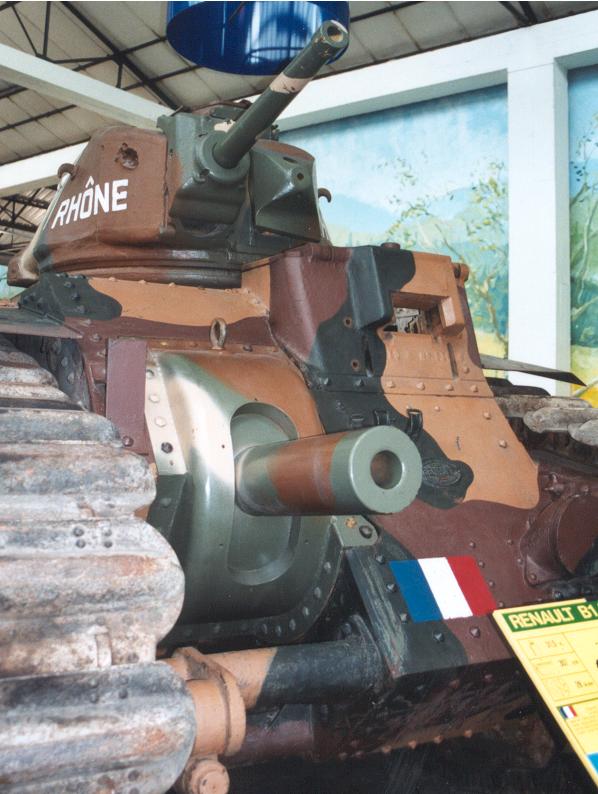
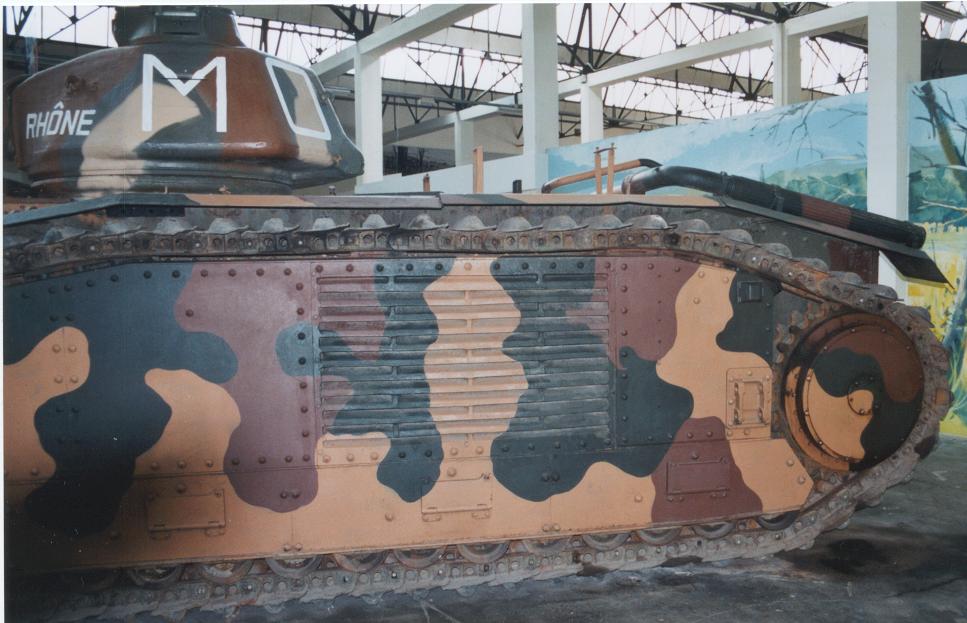 Although the B1bis battle tank was impervious to the 37mm German anti-tank
rounds, combat experience during the western campaign of 1940 would revealed
two major weaknesses in the B1bis battle tank. The first weak point was
just over the hull 75mm gun: AT rounds were found to ricocher on the frontal
upper hull armor ending in the turret ring blocking the turret.
Although the B1bis battle tank was impervious to the 37mm German anti-tank
rounds, combat experience during the western campaign of 1940 would revealed
two major weaknesses in the B1bis battle tank. The first weak point was
just over the hull 75mm gun: AT rounds were found to ricocher on the frontal
upper hull armor ending in the turret ring blocking the turret.
The biggest weakness of the B1bis tank was the ventilation
grate located on the left side of the tank This weak spot in the B1bis
armor would easily be located by german antitank gunners since it would
be blackened by engine fumes. During the course of the campaign in the
west, the german gunners would receive the order to aim at the black rectangle.
These flank shots would be facilitated by the french tactical doctrine
which required the B1bis to attack, moving in zig-zag.
| 2/09/1939 | Sep-39 | Oct-39 | Nov-39 | Dec-39 | Jan-40 | Fev-40 | Mar-40 | Apr-40 | 10/05/1940 | May-40 | Jun-40 | |
| tanks built | 149 (163) | 4 | 11 | 12 | 15 | 25 | 27 | 45 | 32 | 334 | 42 | 27 |
| operational | 132 | - | - | - | - | - | - | - | - | 280 | - | - |
| units | 4 battalions | - | - | - | 5 bns | - | 6 bns | 7 bns | 8 bns | - | + 4 CACC | - |
On January, 16th, 1940, the 1st DCR and 2nd DCR are created:
- 28th BCC and 37th BCC
for the 1st DCR
- 8th BCC and 15th BCC for
the 2nd DCR
On March, 30th, 1940, the 3rd DCR is created:
- 41st BCC and 49th BCC
for the 3rd DCR
On May, 15th, the 4th DCR is created (this division was to be created
on June, 1st):
- 46th BCC and 47th BCC
for the 4th DCR
During the course of May, 3 Tank Autonomous companies (or Compagnies
Autonomones de Chars de Combat) would be created and sent as replacement
to the 2nd DCR. (347th, 348th and 349th CACC). The 28th BCC was also reequipped
with new B1bis.
Early June, a last Tank Autonomous Company will be created and sent
to the Cavalry Corps (352nd CACC).
Therefore of a total of 403 B1bis produced (taking into account the 35 B1 tanks), about 350 tanks would be put into operational units.
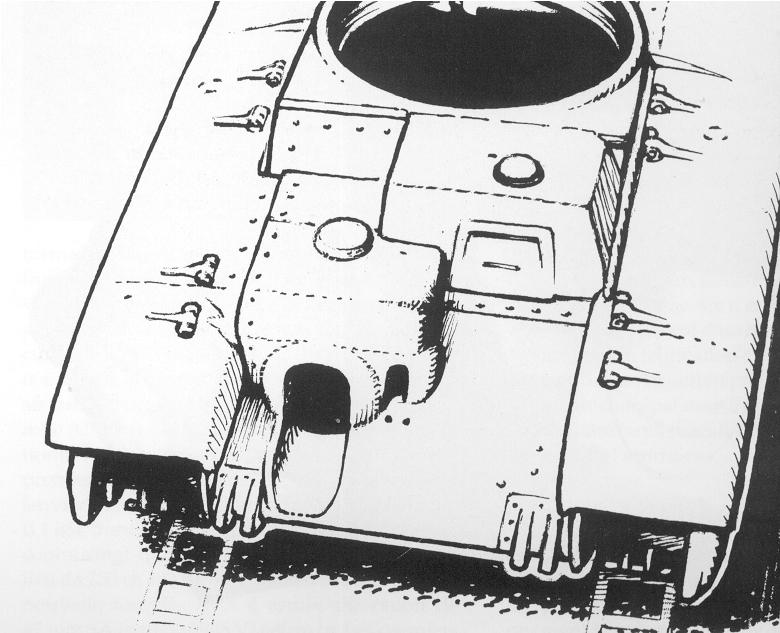
Schematic drawing of the B1ter front hull
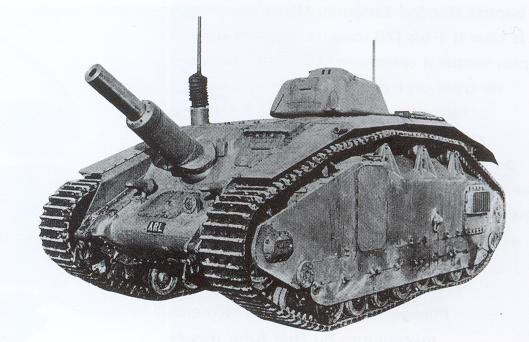
ARL V39 prototype
Most of the 350 B1bis tanks produced had fallen into
german hands by June, 25th, 1940. However, the vast majority has been destroyed
in combat or by its crew, after running out of fuel. Although the tank
was already quite complicated and difficult to maintain operational, the
Germans decided to turn it into a flame thrower tank, given its thick armor.
24 B1bis tanks were transformed into the Fl Wg B-2 , with a FuG5 radio,
a new tank leader cupola and a flame thrower instead of the 75 mm hull
gun. These tanks formed two companies in the 102nd Flame tank battalion
which was comitted for Operation Barbarossa, together with 6 PzKpfw B-2
740 (f) armed with the 75mm howitzer. These B1bis saw action against the
bunker line of Wielke Dzial in 9.Armee sector. By the end of July 1941,
the battalion was disbanded. The 213th schwere Panzerabteilung, formed
late 1941, was given one platoon of Fl Wg B-2 in each of its two companies
of normal PzKpfw B-2 740 (f) where they would all stay until the end of
the war. Twelve Fl Wg B-2 along with 4 PzKpfw B-2 were sent to Crimea in
the summer 1942 as 223rd schwere Panzerkompanie and an unknown number was
sent in the Balkans with 7th SS Gebirgs Division Prinz Eugen together with
7 PzKpfw B-2. In december 1944, 9 Fl Wg B-2 were still available in the
German Order of Battle.
16 B1-bis were converted into a self-propelled light
field howitzer as 10.5cm leFH18/3 (Sf) auf GW B-2 (f) in 1942 and were
issued to various Panzerartillerie detachments serving in France.
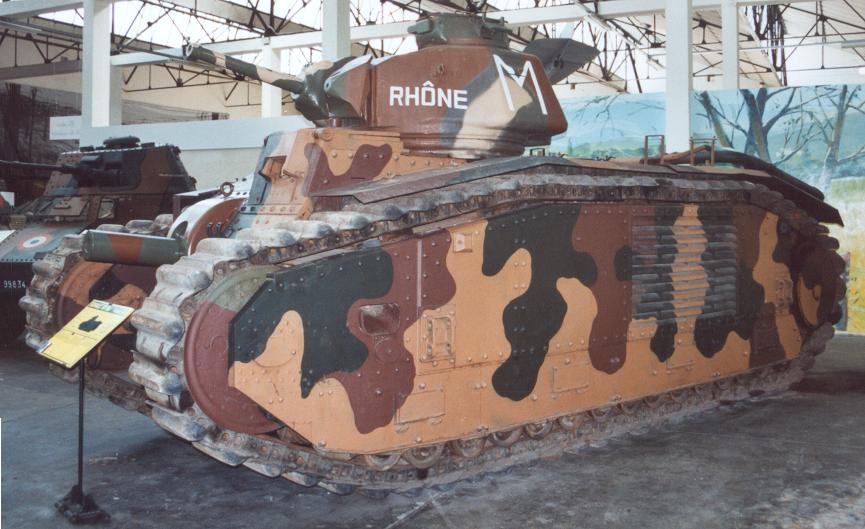
trackwork
Negociated Obstacles
Ground Pressure (kg/cm2): 0.85
Fording Depth (m): 0.72
Performance
Maximum Speed: (km/hr): 28
Range on road (km): 140
Range Cross Country (km): 100
Armament
Main Gun (cm/caliber): 4.7 L/32
Main Gun ammunition: 50
Hull Gun (cm/caliber): 7.5L/17
Hull Gun ammunition: 74
Machine Guns: 2
M.G. ammunition: 5100
Armor: Rolled Hull / Cast Turret
Hull front (mm): 60/45°
Turret front (mm): 55/0°
Hull side (mm): 55/0°
Turret side (mm): 45/22°
Hull rear (mm): 55/0°
Turret rear (mm): 45/22°
Hull roof (mm): 20/90°
Turret roof (mm): 30/90°
Hull belly (mm): 20/90°
Note: the driver front plate was at 20°
Back to Homepage